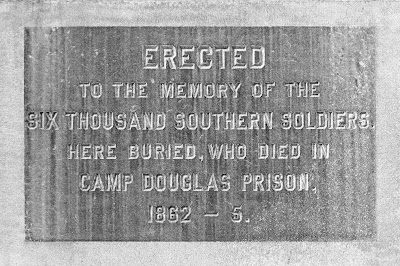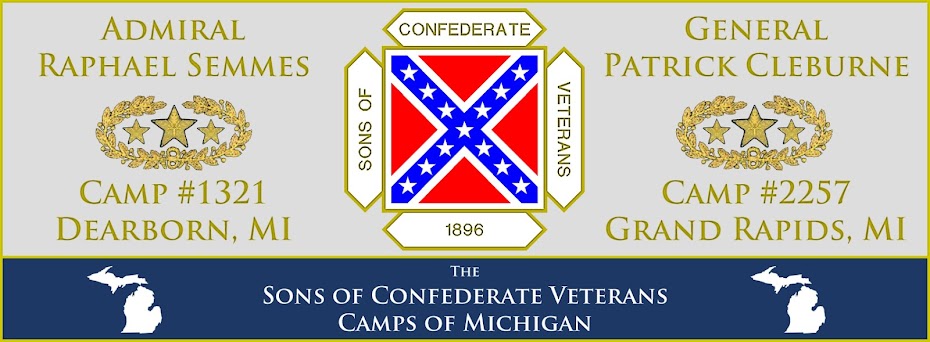Before I go into the details of the memorial service and the events leading up to it, let's take a look at why there are around 6,000 Confederate soldiers buried in Chicago, how the monument at Oak Woods Cemetery came to be and what the 'Confederate Mound' memorial actually consists of.
***CAMP DOUGLAS & THE CONFEDERATE DEAD***
While the prison camp did have two small cemeteries on it's grounds, most of the Confederate dead were originally buried in Chicago's old City Cemetery (located at present day "Lincoln Park"). Several administrative factors after the war forced the U.S. Federal government to find a permanent burial ground for the remains of those who died at Camp Douglas. A lot within Oak Woods Cemetery was selected, and the remains of the Confederate dead were reinterred there, between 1865-1867, in three concentric trenches within an elliptical plot. Once completed, they had inadvertently created what is believed to be the largest mass-grave in the western-hemisphere. The lot became known as "Confederate Mound." (See image below to get an idea of the location of 'Confederate Mound' within the cemetery and the size of the plot.)
After removal of the Confederate remains to Oak Woods Cemetery was completed, the U.S. government took no role in maintaining the mass-grave plot for more than thirty years; The Oak Woods Cemetery Association cut the weeds twice per year. According to the National Cemetery Administration, no markers or memorial were initially placed on the lot, and none would be for nearly three decades.
In 1887, the Ex-Confederate Association of Chicago, largely thanks to the efforts of a former "resident" of Camp Douglas named Thomas P. Longwood, obtained permission from the U.S. Army Quartermaster, Brigadier-General Samuel B. Holabird, to erect a grave monument within the bounds of Confederate Mound. John C. Underwood, a former Confederate engineer who served at the time with the title of "General" in the 'Provisional Army of the North' of the United Confederate Veterans (UCV), was placed in charge of raising funds for the monument by UCV Camp #8 of Chicago in 1892, and was granted permission to erect the monument in May of the next year.
 |
| John C. Underwood, as he appeared during the War years and then in the mid-1890s. |
 |
| Confederate Mound as it appeared in 1895. |
 |
| Maj.Gen. Fitzhugh Lee |
 |
| Lt.Gen. Stephen D. Lee |
 |
| Lt.Gen. James Longstreet |
 |
| Maj.Gen. Matthew C. Butler |
 |
| Maj.Gen. Samuel French |
 |
| Maj.Gen. Henry Heth |
 |
| Maj. Holmes Conrad |
 |
| Col. William L. Calhoun |
 |
| Col. Henry Kyd Douglas |
 |
| Rev. Joseph Desha Pickett Maj. Henry Thompson Stanton |
 |
| Lt.Gen. Wade Hampton delivering the dedicatory address on May 30, 1895 |
***THE MEMORIAL AT CONFEDERATE MOUND***
"The monument ... was constructed by the Southern Granite Company of the widely known 'Pear' granite from it's quarries at Constitution Hill, Ga."
"The lower base or platform is fifteen feet six inches square, upon which are laid three other bases; and, on the front of the center one, cut in raised and polished letters of bold outlines, are the words, 'Confederate dead.' The upper base is adorned with a series of rich mouldings and on the front of this stone is placed an enlarged model of the well-known Confederate seal..."
 |
| [Image Credit: J.M. McCleese; 2018] |
 |
| Confederate Mound in 1895 |
-The Statue-
"The statue is over eight feet high, is that of a Confederate infantryman, and every old soldier will recognize the figure as that of a typical Confederate as he appeared at the close of the war. He stands with folded arms looking down in regret upon the field where hosts of his comrades sleep; with travel-stained clothing and shoes worn, he is the picture of one who has suffered many hardships and whose defeat has been accomplished only after a bitter struggle. He has on the usual accoutrements of the soldier, and his face is typical of southern manhood.
 |
| Image: c. 1895 |
 |
| [Image Credit: J.M. McCleese; 2018] |
 |
| [Image Credit: J.M. McCleese; 2018] |
"The panel on the east represents the 'Call to Arms' at the beginning of the Confederacy and is a very striking scene, one that relates the story at a glance. Here is displayed the front of an old style courthouse, with the numeral 1860 over the door. On one side of the door a southern volunteer in uniform is represented, on the other a number of persons flocking to the entrance are seen, some of them going in. Figures representing men in various conditions of life, the laborer, artisan and professional man are depicted as they are hastening from their avocations, encouraged by their wives and daughters, to enroll themselves beneath the southern battle cross, for the 'call' has gone forth throughout the length and breadth of the south and amid wild and sectional enthusiasm all classes rush to the aid of their country. Many a grizzled veteran gazing at this sculptured bronze picture in these later and quieter days will mentally recall the beginning of the arduous struggle, which has no parallel in history.
 |
| [Image Credit: J.M. McCleese; 2018] |
 |
| [Image Credit: J.M. McCleese; 2018] |
 |
| [Image Credit: J.M. McCleese; 2018] |
"On the north face the following inscription is worked in incised letters upon a polished granite panel: ERECTED TO THE MEMORY OF THE SIX THOUSAND SOUTHERN SOLDIERS HERE BURIED, WHO DIED IN CAMP DOUGLAS PRISON, 1862-5."
 |
| [Image Credit: J.M. McCleese; 2018] |
 |
| [Image Credit: J.M. McCleese; 2018] |
 |
| Image from the May 1895 Dedication |
 |
| Image from the May 1895 Dedication |
***CONFEDERATE MOUND: 1895 - 2018***
On March 9, 1906, the U.S. Congress passed Public Act No. 38, which authorizes, "to provide for the appropriate marking of the graves of the soldiers and sailors of the Confederate army and navy who died in Northern prisons and were buried near the prisons where they died, and for other purposes." This led to federal commissioners floating the idea of installing flat, individual grave markers around the mound for each soldier interred there, but this proposal was never accepted. As a compromise that all parties could agree to, it was decided in 1910 that the existing 1895-monument would be raised and placed on a new base, affixed to which would be bronze plaques bearing the names of 4,275 known Confederates buried there. The work was completed before the end of 1911.
 |
| [Image Credit: J.M. McCleese; 2018] |
[The second half of this story will be published in the coming days. Stay tuned...]
DEO VINDICE!
- Jonathan McCleese
2nd Lieutenant Commander
Admiral Raphael Semmes Camp #1321 (Dearborn, MI)
Army of Tennessee, Sons of Confederate Veterans
---------------------------------------------
Sources:
- ['REPORT OF PROCEEDINGS INCIDENTAL TO THE ERECTION & DEDICATION OF THE CONFEDERATE MONUMENT' by John C. Underwood (1896)]
- ['THE STORY OF CAMP DOUGLAS: CHICAGO'S FORGOTTEN CIVIL WAR PRISON' (Google Books) by David L. Keller (2015)]
- ['FEDERAL STEWARDSHIP OF CONFEDERATE DEAD' (E-Book) by U.S. Department of Veterans Affairs (2016)]
- [CHICAGO MAGAZINE (Online): How the South Side Came to House a Not-So-Controversial Confederate Memorial]
- [NATIONAL CEMETERY ADMINISTRATION: Confederate Mound]
- [NPS.GOV: Confederate Mound at Oak Woods Cemetery]
- [WIKIPEDIA: Camp Douglas (Chicago)]
----------------------------------------------
Notes:
- All historical imagery, including those of the monument & it's dedication from 1895, the portraits of the Confederate officers, and the historic quotations have been used from Underwood's 1896 book.
- All images marked [Image Credit: J.M. McCleese; 2018] are the property of Jonathan McCleese, and may be used without permission by any individual or organization that seeks to honor Confederate Veterans and their cause of Southern Independence, provided that recognition is given to Admiral Raphael Semmes Camp #1321 (Dearborn, MI), Sons of Confederate Veterans; all others seeking to use these images must seek permission.




No comments:
Post a Comment
Comments and questions are most welcome, but keep in mind that this is not a forum for debate. Keep all comments respectful, clean (no "foul language"), and on topic of the post. If you need information about the camps, the SCV, or how to join this organization, please refer to the links provided in the sidebar on the right of the page. Thanks!